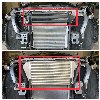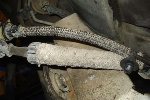- Joined
- June 17, 2004
- Messages
- 24,263
- Reaction score
- 4,729
- City, State
- Knoxville, TN
- Year, Model & Trim Level
- 98 Limited AWD 302
I talk straight, that's just me, and yes it rubs some people the wrong way. I've never been politically correct or properly tactful, just honest to a fault.
Here's an example; the 351's, all of them are actually 352's. The displacement is identical to a 352 FE big block, and Ford decided to misname all of the 351's because of the old 352's. Why in 1969 did anyone think an old defunct/rare big block name would ever confuse people. I call them 351's because I grew up with them, but I knew the actual displacement too.
The stroker 302's with a 3.25" crank, those are all 332's, not 331's. I plan to build one soon, and I'll call it a 332. I plan a 351 for my Ranchero, but it'll be a 302 block with a 3.4" crank, and a .060" over bore, thus the same displacement as all 351's, but with 3V heads, so a 351-3V on the air cleaner decal.
Here's an example; the 351's, all of them are actually 352's. The displacement is identical to a 352 FE big block, and Ford decided to misname all of the 351's because of the old 352's. Why in 1969 did anyone think an old defunct/rare big block name would ever confuse people. I call them 351's because I grew up with them, but I knew the actual displacement too.
The stroker 302's with a 3.25" crank, those are all 332's, not 331's. I plan to build one soon, and I'll call it a 332. I plan a 351 for my Ranchero, but it'll be a 302 block with a 3.4" crank, and a .060" over bore, thus the same displacement as all 351's, but with 3V heads, so a 351-3V on the air cleaner decal.










